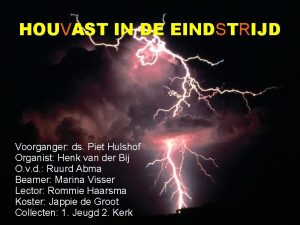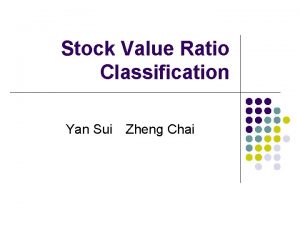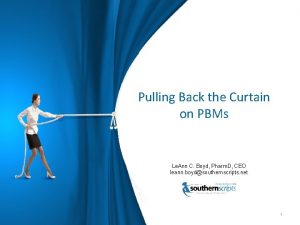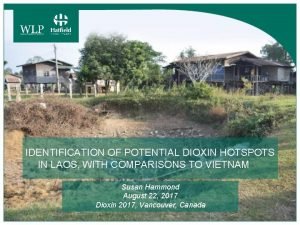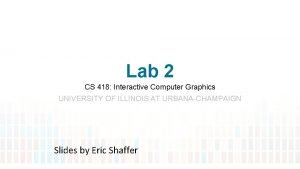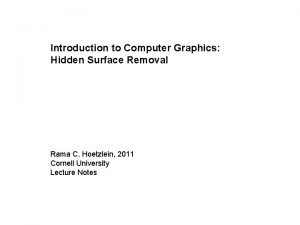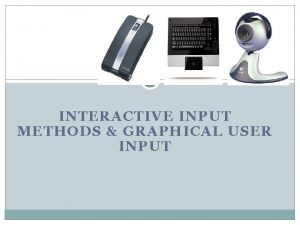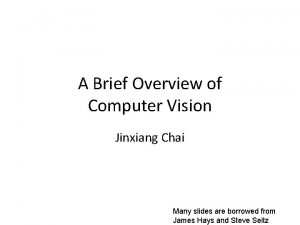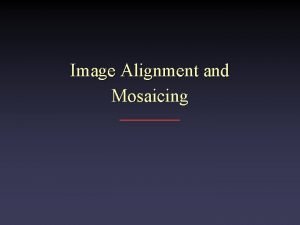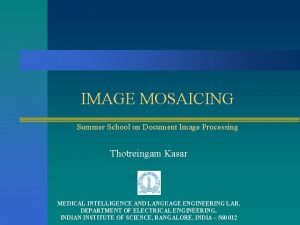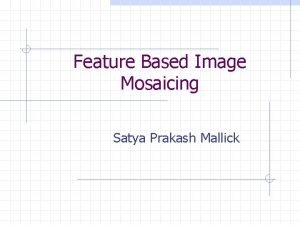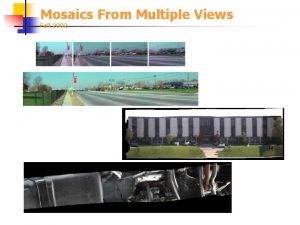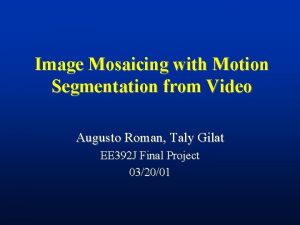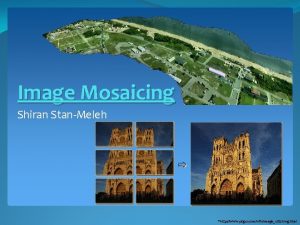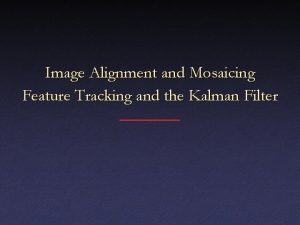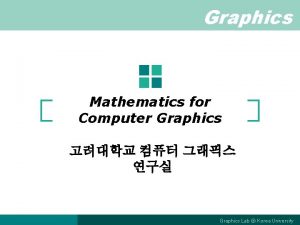CSCE 641 Computer Graphics Image Mosaicing Jinxiang Chai




































- Slides: 36

CSCE 641 Computer Graphics: Image Mosaicing Jinxiang Chai Source: faculty. cs. tamu. edu/jchai/cpsc 641_spring 10/lectures/lecture 8. ppt

Outline Image registration - How to break assumptions? 3 D-2 D registration Image mosaicing

Mosaics: Stitching Image Together virtual wide-angle camera

Mosaic Procedure Basic Procedure

Mosaic Procedure Basic Procedure – Take a sequence of images from the same position • Rotate the camera about its optical center

Mosaic Procedure Basic Procedure – Take a sequence of images from the same position • Rotate the camera about its optical center – Compute transformation between second image and first

Mosaic Procedure Basic Procedure – Take a sequence of images from the same position • Rotate the camera about its optical center – Compute transformation between second image and first – Transform the second image to overlap with the first

Mosaic Procedure Basic Procedure – Take a sequence of images from the same position • Rotate the camera about its optical center – Compute transformation between second image and first – Transform the second image to overlap with the first – Blend the two together to create a mosaic

Mosaic Procedure Basic Procedure – Take a sequence of images from the same position • Rotate the camera about its optical center – Compute transformation between second image and first – Transform the second image to overlap with the first – Blend the two together to create a mosaic – If there are more images, repeat

Image Mosaic Is a pencil of rays contains all views real camera synthetic camera Can generate any synthetic camera view as long as it has the same center of projection!

Image Re-projection mosaic PP The mosaic has a natural interpretation in 3 D – The images are reprojected onto a common plane – The mosaic is formed on this plane – Mosaic is a synthetic wide-angle camera

Issues in Image Mosaic How to relate two images from the same camera center? - image registration How to re-project images to a common plane? - image warping ? ? mosaic PP

Image Mosaicing Geometric relationship between images

Image Mosaicing Geometric relationship between images – Use 8 -parameter projective transformation matrix

Image Mosaicing Geometric relationship between images – Use 8 -parameter projective transformation matrix – Use a 3 D rotation model (one R per image) Derive it by yourself!

Image Mosaicing Geometric relationship between images – Use 8 -parameter projective transformation matrix – Use a 3 D rotation model (one R per image) Register all pairwise overlapping images – Feature-based registration – Pixel-based registration Chain together inter-frame rotations

Image Stitching Stitch pairs together, blend, then crop

Image Stitching A big image stitched from 5 small images

Panoramas What if you want a 360 field of view? mosaic Projection Cylinder

Cylindrical Panoramas Steps – Re-project each image onto a cylinder – Blend – Output the resulting mosaic

Cylindrical Projection – Map 3 D point (X, Y, Z) onto cylinder Y Z X unit cylinder

Cylindrical Projection – Map 3 D point (X, Y, Z) onto cylinder – Convert to cylindrical coordinates Y Z X unit cylinder unwrapped cylinder

Cylindrical Projection – Map 3 D point (X, Y, Z) onto cylinder – Convert to cylindrical coordinates Y Z X unit cylinder – Convert to cylindrical image coordinates • s defines size of the final image unwrapped cylinder cylindrical image

Cylindrical Panoramas A B mosaic Projection Cylinder Cannot map point A to Point B without knowing (X, Y, Z)

Cylindrical Panoramas A B C mosaic Projection Cylinder But we can map point C (images) to Point B.

Cylindrical Warping Given focal length f and image center (xc, yc) (X, Y, Z) Y (sinq, h, cosq) Z X

Cylindrical Panoramas Map image to cylindrical or spherical coordinates – need known focal length Image 384 x 300 f = 180 (pixels) f = 280 f = 380

Cylindrical Panorama 3 D rotation registration of four images taken with a handheld camera.

Cylindrical Panorama

Recognizing panoramas • A fully automatic 2 D image stitcher system Input Images Output panorama #1

Recognizing panoramas • A fully automatic 2 D image stitcher system Input Images Output panorama #2

Recognizing panoramas • A fully automatic 2 D image stitcher system Input Images Output panorama #3

Recognizing panoramas • A fully automatic 2 D image stitcher system Input Images - How to recognize which images can be used for panoramas? - How to stitch them automatically?

Recognizing panoramas • A fully automatic 2 D image stitcher system

Recognizing panoramas • A fully automatic 2 D image stitcher system - Image matching with SIFT features - For every image, find the M best images with RANSAC - Form a graph and find connected component in the graph - Stitching and blending.

Outline Image registration - How to break assumptions? (cont. ) 3 D-2 D registration Image mosaicing
 Jinxiang chai
Jinxiang chai Jinxiang chai
Jinxiang chai Image mosaicing
Image mosaicing Graphics monitors and workstations and input devices
Graphics monitors and workstations and input devices Introduction to computer graphics ppt
Introduction to computer graphics ppt Tmf 641
Tmf 641 Sba gls account
Sba gls account Lied 641 jezus leeft en ik met hem
Lied 641 jezus leeft en ik met hem Tmf 638
Tmf 638 641 x 3
641 x 3 Dr david tsen
Dr david tsen Yidong chai
Yidong chai Czarif chai abdullah
Czarif chai abdullah Bà tôi ngồi cạnh tôi chải đầu
Bà tôi ngồi cạnh tôi chải đầu Bận lòng chi nắm bắt
Bận lòng chi nắm bắt Chai ratio
Chai ratio Chai mail curtain
Chai mail curtain Kop chai lai lai
Kop chai lai lai Angel
Angel Projection types in computer graphics
Projection types in computer graphics Display devices in computer graphics
Display devices in computer graphics In two dimensional viewing we have?
In two dimensional viewing we have? Shear transformation in computer graphics
Shear transformation in computer graphics Acos glsl
Acos glsl Scan conversation
Scan conversation Center of mass of a rigid body
Center of mass of a rigid body Is the process of filling image or region.
Is the process of filling image or region. Character generation methods in computer graphics
Character generation methods in computer graphics Fill polygon algorithm
Fill polygon algorithm Random scan display
Random scan display Computer graphics
Computer graphics Which of the following is a line drawing algorithm
Which of the following is a line drawing algorithm Cs 418
Cs 418 Cs 418 interactive computer graphics
Cs 418 interactive computer graphics Introduction to hidden surface removal
Introduction to hidden surface removal Achromatic light in computer graphics
Achromatic light in computer graphics Interactive input devices
Interactive input devices







